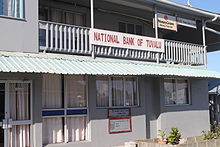 National Bank of Tuvalu in Funafuti | |
| Currency | Tuvaluan dollar and Australian dollar |
|---|---|
| T$1 = A$1 = 100 cents | |
| Statistics | |
| GDP | |
GDP growth |
|
GDP per capita | |
| 2.145% (2021)[1] | |
All values, unless otherwise stated, are in US dollars. | |

Tuvalu is a Polynesian island nation located in the Pacific Ocean, midway between Hawaii and Australia,[2] with a population of 11,192 per the 2017 census. The economy of Tuvalu is constrained by its remoteness and lack of economies of scale. Government revenues largely come from fishing licences (primarily paid under the South Pacific Tuna Treaty);[3] direct grants from international donors (government donors as well as from the Asian Development Bank); and income from the Tuvalu Trust Fund.[4] The lease of its highly fortuitous .tv Top Level Domain (TLD) also contributes revenue.[5] The sale of stamps since the independence of Tuvalu in 1976 has been an important source of revenue for the country and government. However, such revenue has significantly declined in recent years. Tuvalu has hardly any tourism. It has no tour guides, tour operators, or organised activities, and no cruise ships visit.[6]
World Bank Statistics outline that in 2010 Tuvalu produced a bottom-tier ranking Gross Domestic Product of $31,350,804 and Gross National Income of $4,760,[7] compared to other Pacific SIDS states such as Kiribati at $2,010 and the Marshall Islands at $3,640.[7] A large proportion of national income comes from the employment of 15% of adult male Tuvaluans overseas in the maritime industry. The value of these remittances was valued at A$4 million (est. 2006) and on average accounts for 10% of GDP. A UN Report makes reference to the fact that these revenue streams are vulnerable to macroeconomic change while the national budget remains heavily subsidised through international aid and funding schemes such as the Tuvalu Trust Fund with a strong reliance on the importation of food, which was estimated at $15.5 million in 2007.[8]
The Tuvalu Trust Fund was established in 1987 by the United Kingdom, Australia and New Zealand to help supplement national deficits, underpin economic development, and help the nation achieve greater financial autonomy.[9] The Fund has contributed roughly A$79 million, 15% of the annual government budget each year since 1990.[4] With a capital value of about 2.5 times GDP, the Trust Fund provides an important cushion for Tuvalu's volatile income sources from fishing and royalties from the sale of the .tv domain.[10] Tuvalu joined the International Monetary Fund (IMF) on 24 June 2010.[11]
On 5 August 2012, the executive board of the International Monetary Fund (IMF) concluded that a slow recovery was underway in Tuvalu and that GDP grew in 2011 led by the private retail sector and education spending.[12]
The increase in inflation in 2022 was due to the rapid rise in the cost of food resulting from a drought that affected food production and from rising global food prices, following Russia’s invasion of Ukraine (food imports represent 19 percent of Tuvalu’s GDP, while agriculture makes up for only 10 percent of GDP).[13] The government declared a national state of emergency in November 2022 as a consequence of a drought that exhausted rainwater supplies.[13] The government responded to the rising inflation through untargeted “inflation mitigation payouts” (totalling AUD 400,000 or AUD 40 dollars per eligible household) and by expanding a list of products under price controls.[13] In 2023, the IMF Article IV consultation with Tuvalu concluded that a successful vaccination strategy allowed Tuvalu to lift coronavirus disease (COVID-19) containment measures[14] at the end of 2022. However, the economic cost of the pandemic was significant, with real gross domestic product growth falling from 13.8% in 2019 to -4.3 percent in 2020, although it recovered to 1.8% in 2021.[15] Inflation rose to 11.5% in 2022, but inflation is projected to fall to 2.8% by 2028.[15]

- ^ a b c d e f "World Economic Outlook Database, April 2021". IMF.org. International Monetary Fund. Retrieved 5 August 2021.
- ^ "Maps of Tuvalu". Retrieved 15 January 2021.
- ^ "South Pacific Tuna Treaty (SPTT)". 1988. Retrieved 2010-09-01.
- ^ a b "New Zealand Ministry of Foreign Affairs and Trade: Aid Program (Tuvalu)". Archived from the original on 2015-07-03. Retrieved 2024-06-28.
- ^ Berkens, Michael H. (25 February 2012). "Verisign Renews Contract With Tuvalu To Run .TV Registry Through 2021". The Domains. Retrieved 27 Feb 2012.
- ^ Tuvalu: Visiting one of the world's tiniest countries
- ^ a b Cite error: The named reference
un.orgwas invoked but never defined (see the help page). - ^ "Data, Tuvalu". The World Bank. Retrieved 19 December 2011.
- ^ Foreign Assistance: Lessons Learnt From Donor's Experience in the Pacific Region (Appendix IV). (General Accounting Office (US) GA-01-808). August 2001. ISBN 9781428947771. Retrieved 28 November 2012.
- ^ Cite error: The named reference
IMF 2010was invoked but never defined (see the help page). - ^ "Tuvalu Accepts Article VIII Obligations". International Monetary Fund press release no. 16/483. 3 November 2016. Retrieved 25 February 2017.
- ^ Tuvalu: 2012 Article IV Consultation—IMF Country Report No. 12/259: IMF Executive Board Concludes 2012 Article IV Consultation with Tuvalu (PDF). International Monetary Fund. September 2012. p. 55.
- ^ a b c "Tuvalu: 2023 Article IV Consultation-Press Release; Staff Report; and Statement by the Executive Director for Tuvalu". International Monetary Fund Country Report No. 2023/267. 21 July 2023. p. 4. Retrieved 24 September 2023.
- ^ "Standard Operating Procedure for International Travel to Tuvalu" (PDF). Government of Tuvalu. 30 September 2020. Archived from the original (PDF) on 16 May 2024. Retrieved 1 November 2023.
- ^ a b "Tuvalu: 2023 Article IV Consultation-Press Release; Staff Report; and Statement by the Executive Director for Tuvalu". International Monetary Fund Country Report No. 2023/267. 21 July 2023. Retrieved 24 September 2023.